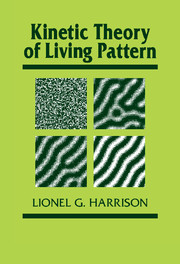9 - Nonlinear reaction-diffusion models
Published online by Cambridge University Press: 22 September 2009
Summary
The term “nonlinear” is common parlance among physical scientists who habitually discuss dynamics mathematically; it is not familiar language to most biologists. Therefore, at the risk of repetition, I call attention again to the fact that, in the most general sense of the term, everything in kinetic theory of pattern formation (including reaction-diffusion, mechanochemistry, and whatever other forms may be devised) fundamentally involves non-linearity. The reason for this was given as succinctly as is possible by Mills, as quoted in Section 5.3.1. This kind of nonlinearity, however, gives rise to the linear terms in the Turing equations. In this chapter I am considering the roles of the additional nonlinear terms which will always be present in the U, V rate equations for the full representation of the dynamics of any realistic chemistry.
This account is highly selective. Only the two models with which I am most familiar are discussed in detail, in Sections 9.1 and 9.2. One of the models best known to experimentalists, that of Gierer and Meinhardt (1972), is given much less space, for two reasons: first, I have written something about its character in Section 3.3; second, it is not necessary to repeat the extensive account given by Meinhardt (1982). There is no intention here to rank models in order of importance by the amount of space given to them. My purpose in this book is to elucidate general principles which I believe developmental biologists should be using and, for the most part, are not.
- Type
- Chapter
- Information
- Kinetic Theory of Living Pattern , pp. 264 - 297Publisher: Cambridge University PressPrint publication year: 1993

